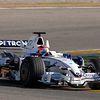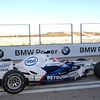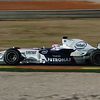BMW presents the F1.08 in Munich

The BMW Sauber F1 Team took delivery of the fastest car in the BMW range at BMW Welt in Munich today. The team was presented with the BMW Sauber F1.08 against the futuristic backdrop of the brand’s new vehicle delivery centre.
The presentation, which took place before an audience of several hundred media representatives from around the world, included a spectacular cameo from Nick Heidfeld. As the longest-serving F1 driver in the BMW ranks, the German took the new car for a spin inside the vast building. The serious testing, however, will begin tomorrow with the roll-out of the car at the Valencia race circuit in Spain. The BMW Sauber F1.08 is eye-catching with its imposing front wing and extremely slim rear, and boasts a wealth of innovative technology.
The BMW Sauber F1 Team has completed its development phase, motivation is strong and its plans are ambitious: in what will be its third season on the Formula One grid the team is aiming to close the gap to the leading teams and has targeted a first race win. “We’re setting our sights high,” admits BMW Motorsport Director Mario Theissen, “and we’ll have to make further improvements in all areas to achieve what we want to. However, the past two years have instilled confidence within the team. We met our goals in both 2006 and 2007, we are heading in the right direction, and everybody in Munich and Hinwil is focused on the job in hand. If we continue our progress along this path we will also fulfil our aims for 2008.”
The team will take on the challenge with the same race drivers as in 2007 – Germany’s Nick Heidfeld (30) and his Polish team-mate Robert Kubica (23) will be at the wheel of the BMW Sauber F1.08 for the 18 grands prix which make up the 2008 FIA Formula One World Championship. The team will not name a test driver until the end of January.
“It is generally very difficult to define expectations and make prognoses. But I hope that our plan works out and we are able to win our first race in 2008,“ said Heidfeld, who once again accounted for the largest share of the points earned by the team in 2007 and finished on the podium twice. “I expect us to move forward in all areas – particularly as far as reliability is concerned – and to learn from our mistakes. This development process is essential in what we’re trying to achieve.”
And Kubica adds: “I will also be looking to achieve greater consistency in my results during my second full season in Formula One. Retirements and that crash in Canada – which also prevented me from starting in the USA – cost me points in 2007. We all need to take further steps forward in 2008 and make maximum use of every opportunity that presents itself.”
Theissen holds his two drivers in high regard: “In Nick and Robert we have a strong and evenly matched duo. For our young team, which in 2006 and 2007 had to drive forward its development in terms of structure and personnel alongside its World Championship campaign, consistency is also a great asset. We know that these two drivers will get the maximum out of the machinery we give them. The F1.07 was a good car, so on this basis the F1.08 should be even better.”
The new BMW Sauber F1.08
For Technical Director Willy Rampf the philosophy behind the race car for the 2008 season boils down to what he calls “evolutionary new development”. In other words, last year’s car already provided the engineers with a sound basis for the BMW Sauber F1.08, and they did not have to spend time correcting faults. Instead they were able to use knowledge gained over the course of the 2007 season and channel their energies into the development of innovations which build on this basis.
The engineers’ development work focused on achieving a high level of aerodynamic efficiency coupled with a stable aero balance: the lower the loss of downforce through corners, the faster the car can travel and the greater the confidence it gives the driver. Other development aims included improving mechanical grip in order to make the best possible use of the standard tyres and reducing the weight of various components to allow maximum use of ballast in optimising weight distribution.
A particularly eye-catching feature of the F1.08 is the mighty front wing. Having said that, the car’s nose has actually slimmed down – in equal measure to the rear end. The narrower engine cover has been designed with all-new extra wing elements. Another new and immediately noticeable feature are the hub caps, or “rim shields”.
Two changes to the regulations have had a major effect on the construction of the cars for the 2008 season: the introduction of standardised electronics (SECU) and the new running time stipulation for the gearboxes (developed in Munich), which must now endure over four grands prix. Since the SECU does not allow for traction control, among other functions, mechanical grip and sensitive accelerator control will gain in importance.
“The data which the F1.08 has delivered ahead of its roll-out is extremely promising,” says Rampf. “The development work will continue at full speed up to the start of the new season. Indeed, another aero package will be added to the F1.08 at the forthcoming test, and this will also alter the external appearance of the car once again.”







